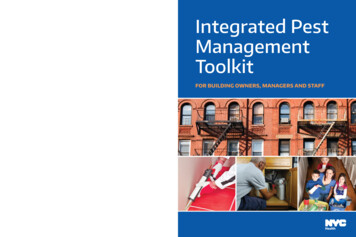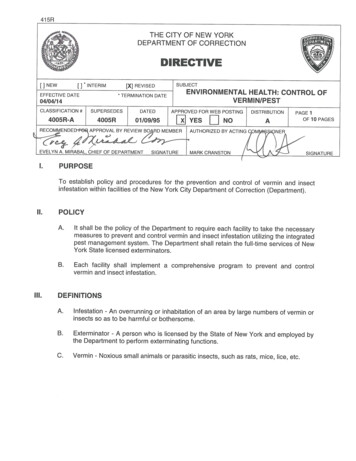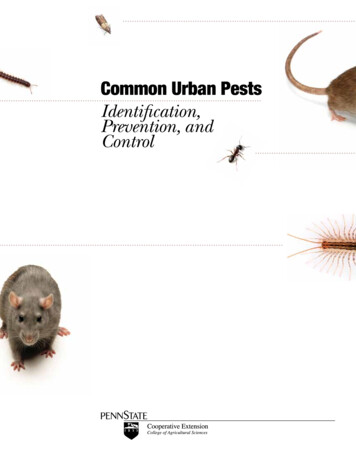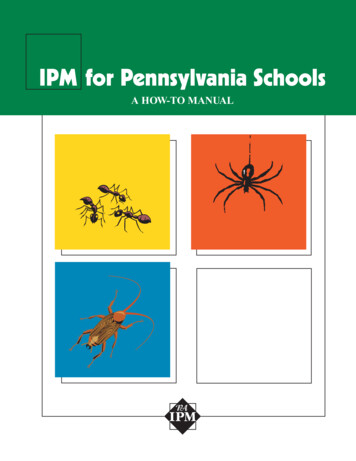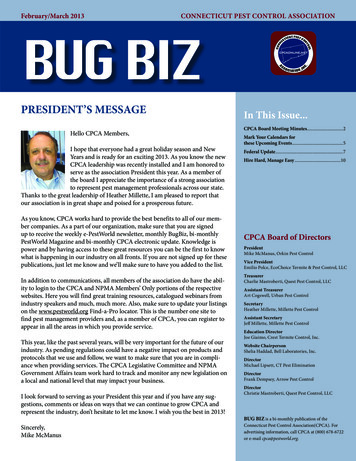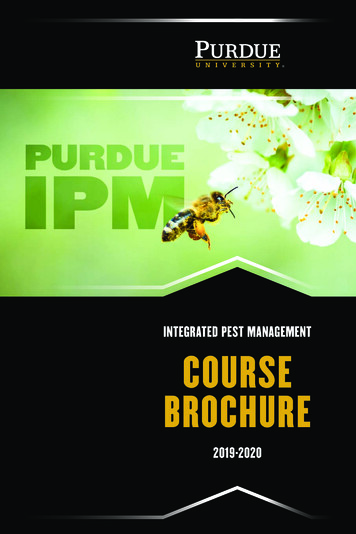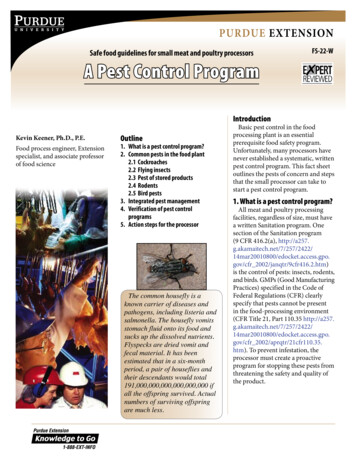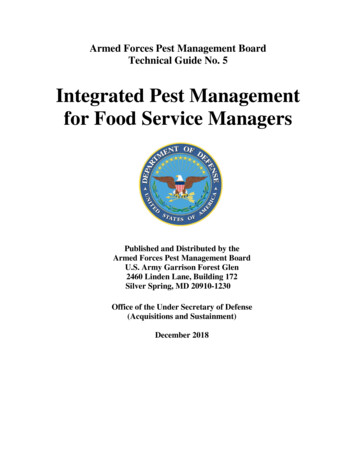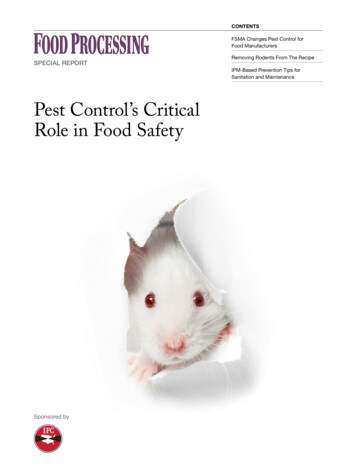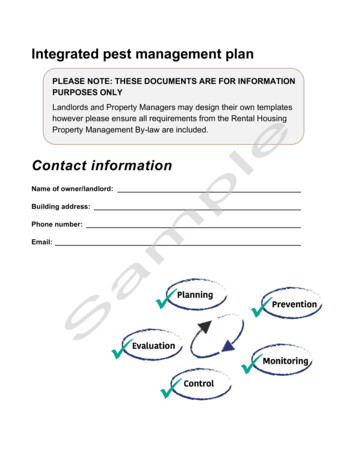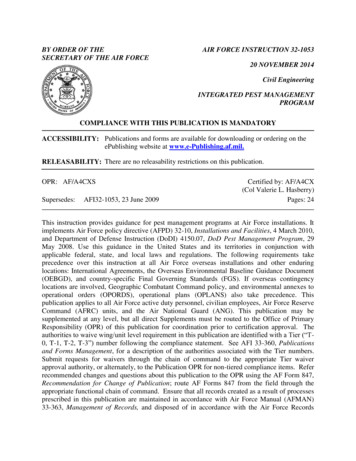
Transcription
BY ORDER OF THESECRETARY OF THE AIR FORCEAIR FORCE INSTRUCTION 32-105320 NOVEMBER 2014Civil EngineeringINTEGRATED PEST MANAGEMENTPROGRAMCOMPLIANCE WITH THIS PUBLICATION IS MANDATORYACCESSIBILITY: Publications and forms are available for downloading or ordering on theePublishing website at www.e-Publishing.af.mil.RELEASABILITY: There are no releasability restrictions on this publication.OPR: AF/A4CXSSupersedes:AFI32-1053, 23 June 2009Certified by: AF/A4CX(Col Valerie L. Hasberry)Pages: 24This instruction provides guidance for pest management programs at Air Force installations. Itimplements Air Force policy directive (AFPD) 32-10, Installations and Facilities, 4 March 2010,and Department of Defense Instruction (DoDI) 4150.07, DoD Pest Management Program, 29May 2008. Use this guidance in the United States and its territories in conjunction withapplicable federal, state, and local laws and regulations. The following requirements takeprecedence over this instruction at all Air Force overseas installations and other enduringlocations: International Agreements, the Overseas Environmental Baseline Guidance Document(OEBGD), and country-specific Final Governing Standards (FGS). If overseas contingencylocations are involved, Geographic Combatant Command policy, and environmental annexes tooperational orders (OPORDS), operational plans (OPLANS) also take precedence. Thispublication applies to all Air Force active duty personnel, civilian employees, Air Force ReserveCommand (AFRC) units, and the Air National Guard (ANG). This publication may besupplemented at any level, but all direct Supplements must be routed to the Office of PrimaryResponsibility (OPR) of this publication for coordination prior to certification approval. Theauthorities to waive wing/unit level requirement in this publication are identified with a Tier (“T0, T-1, T-2, T-3”) number following the compliance statement. See AFI 33-360, Publicationsand Forms Management, for a description of the authorities associated with the Tier numbers.Submit requests for waivers through the chain of command to the appropriate Tier waiverapproval authority, or alternately, to the Publication OPR for non-tiered compliance items. Referrecommended changes and questions about this publication to the OPR using the AF Form 847,Recommendation for Change of Publication; route AF Forms 847 from the field through theappropriate functional chain of command. Ensure that all records created as a result of processesprescribed in this publication are maintained in accordance with Air Force Manual (AFMAN)33-363, Management of Records, and disposed of in accordance with the Air Force Records
2AFI32-1053 20 NOVEMBER 2014Disposition Schedule (RDS) located in the Air Force Records Information Management System(AFRIMS). The use of the name or mark of any specific manufacturer, commercial product,commodity, or service in this publication does not imply endorsement by the Air Force.SUMMARY OF CHANGESThis document has been substantially revised and must be completely reviewed. Major changesinclude the addition of Tier wavier authority requirements, updated office symbols, and updatedreferences.1.Background. .22.Objectives. .23.Responsibilities. .24.Procedures. .145.Technical Publications and Pest Management Websites. .18Attachment 1—GLOSSARY OF REFERENCES AND SUPPORTING INFORMATION191. Background. Air Force pest management programs are essential to prevent pest and diseasevectors from adversely affecting military operations in peacetime and during contingencyoperations. Safe, effective, and environmentally sound Integrated Pest Management (IPM)programs reduce pollution and other risk factors associated with pesticide use.2. Objectives. The objectives of the Air Force pest management programs are to meet orexceed DoD pest management Measures of Merit (MoM), and promote and support thefollowing:2.1. Military readiness.2.2. Installation program planning and maintenance.2.3. Pollution prevention, conservation of natural/cultural resources, and environmentalcompliance.2.4. IPM.3. Responsibilities.3.1. Assistant Secretary (Intallations, Environment and Energy). Provide oversight forall matters pertaining to the formulation, review and execution of IPM plans, policies,programs, and budgets.3.2. Air Force Director of Civil Engineers. Approves implementation of Air Force PestManagement policies for Active Duty and AFRC installations. The National Guard BureauCivil Engineer approves Air National Guard (ANG) policy.3.3. Air Force Medical Support Agency (AFMSA). Coordinate with AFMSA PublicHealth (SG3PM) and Bioenvironmental Engineering (SG3PB) branches on aspects of the
AFI32-1053 20 NOVEMBER 20143pest management program that present potential occupational and environmental healthhazards. Note: ANG/A7AN provides comparable services for ANG Installations. (T-1)3.4. Air Force Civil Engineer Center (AFCEC). Provide a pest management subjectmatter expert who acts as the Air Force senior pest management consultant and whoseresponsibilities are as follows:3.4.1. Set standards, develop procedures, and provide technical assistance to implementAir Force policy and programs for in-service and contract pest management operations.(T-1)3.4.2. Coordinate with engineering and medical operations to ensure the Air Force hasadequate combat pest management capability. (T-1)3.4.3. Ensure all Major Command (MAJCOM) pest management consultants (PMC) arecurrently certified in the appropriate DoD pest management categories. (T-0)3.4.4. Establish the Air Force self-help pest management program. (T-1)3.4.5. Coordinate with Office of Secretary of Defense and Air Force for the developmentand maintenance of a computerized integrated pest management information system(IPMIS). (T-0)3.4.6. Forward contingency pest management records to the U.S. Army Public HealthCommand (USAPHC) in accordance with DoDI 6490.03, Deployment Health, forarchiving in the Defense Occupational and Environmental Health Readiness System(DOEHRS). (T-0)3.4.7. Represent the Director of Civil Engineers as a voting council member on theArmed Forces Pest Management Board (AFPMB) (http://www.afpmb.org). (T-1)3.4.8. Collect MAJCOM pest management data and analyze for Air Force-wide issues;consolidate and validate Air Force data for the DoD Pest Management (PM) MoMsubmittal; and forward through Director of Civil Engineers to the AFPMB. (T-1)3.5. MAJCOM (through MAJCOM Pest Management Consultant [PMC]).3.5.1. Implement pest management policies and programs for their installations.3.5.2. Use the most recent Management Internal Control Toolset (MICT) PesticideManagement Communicator and applicable sections of AFPMB Technical Guide (TG)No. 18, Installation Pest Management Program Guide, to assess the effectiveness ofinstallation pest management programs; review installation pest management programson-site at least every 36 months, and annually review installation pest management plansfor adherence to DoD and Air Force policy.3.5.3. Identify personnel needing pesticide applicator certification or recertificationduring the annual training survey.3.5.4. Certify only military and DoD civilian pest management personnel who have metthe training requirements (in-residence training, correspondence course, and on-the-jobtraining) for pesticide applicator certification as specified in the AFPMB document,Department of Defense Manual (DoDM) 4150.07, Volume (V)1, DoD Pest ManagementTraining and Certification Program: DoD Plan for the Certification of Pesticide
4AFI32-1053 20 NOVEMBER 2014Applicators. (Provide all certified pest management personnel with (Department ofDefense) DD Form 1826, Certificate of Competency, and DD Form 1826-1, PesticideApplicator Card. Pesticide applicator certification is valid for three years from the dategraduated from one of the following training classes: Pest Management Apprentice, PestManagement Pesticide Applicator Recertification Training, or Pest ManagementCertification Training, unless revoked for cause.)3.5.5. Review and approve installation pest management plans, pesticide requests,contract performance work statements, aerial spray projects IAW AFI 32-1074, AerialApplication of Pesticides, and facility design and/or upgrades.3.5.6. Program adequate resources to ensure program reviews, training, and compliancerequirements are met.3.5.7. Help installations implement the IPMIS computerized pesticide database, andannually forward the consolidated pest management data to AFCEC/Civil Branch(COSC).3.5.8. Consolidate base DoD PM MoM and Air Force Scorecard submittals, analyze forMAJCOM-wide issues, validate, and forward to AFCEC/COSC.3.6. Air Force Installation Engineer/Civil Engineer Squadron Commander.3.6.1. Provide oversight and support of all installation pest management programs inaccordance with DoD, federal, state, and legally applicable host nation laws. (T-0)3.6.2. Provide facilities, equipment, and pesticides in accordance with DoDI 4150.07,DoD Pest Management Program. (T-0)3.6.3. Provide the appropriate number of certified pest management personnel accordingto DoDI 4150.07 and Air Force manpower standards to support contingency andinstallation requirements. (T-0)3.6.4. Provide financial resources for operations and training to meet installation andcontingency pest management requirements. (T-1)3.6.5. Select (in writing) an installation pest management supervisor/coordinator (IPMC)to oversee the development of installation pest management plans, collect and report dataon all installation pesticide use, review contract specifications, and serve as the primarypoint of contact (POC) for all installation pesticide compliance. (T-1)3.6.6. Annually review and approve installation pest management plans and contracts.(T-1)3.6.7. Provide pest management support for installation facilities, grounds, airfieldBird/Wildlife Air Strike Hazard (BASH) mitigation measures, range operations, golfcourse maintenance (in accordance with AFI 65-106, Appropriated Fund Support ofMorale, Welfare, and Recreation [MWR] and Non-appropriated Fund Instrumentalities[NAFIS]), recreation areas, etc. (T-1)3.7. Air Force Installation Pest Management Supervisor/Coordinator. The Air Forceinstallation pest management supervisor/coordinator works in the civil engineer (CE) career
AFI32-1053 20 NOVEMBER 20145field and is responsible for the installation's pest management program and performs thefunctions of the installation pest management coordinator as specified in DoDI 4150.07.(T-0)3.7.1. Overall Responsibilities.3.7.1.1. Work closely with other CE, services, medical personnel, and the MAJCOMPMC to produce an effective pest management program.3.7.1.2. With assistance from the installation environmental office, coordinate withfederal, state, installation, local or host nation pest management, environmental, andwildlife personnel as necessary. (T-0)3.7.2. Regulatory Compliance.3.7.2.1. Ensure pest management programs and facilities comply with all applicablefederal, state, and local laws, DoD instructions, and Air Force requirements; followguidance in AFPMB TG No. 17, Design of Pest Management Facilities, for designingnew facilities and renovating existing facilities; consult with bioenvironmentalengineering personnel regarding the adequacy of the pest management facility toensure it provides a safe work environment for pest management personnel. (T-0)3.7.2.2. Use pesticides approved in writing by the MAJCOM PMC in accordancewith Environmental Protection Agency (EPA) label requirements. Ensure theprocurement of hazardous material pesticides follows AFI 32-7086, HazardousMaterial Management, procedures. (T-0)3.7.2.3. Review the most recent MICT Pesticide Management Communicator forguidance. (T-3)3.7.2.4. For overseas installations outside U.S. jurisdiction, apply the FGS asdeveloped under DoD 4715.5G, Overseas Environmental Baseline GuidancePesticide Management Checklist, for the host country; ensure host nation personnelreceive non-FIFRA training in accordance with DoDI 4150.07 and the FGS. (T-0)3.7.2.5. Follow requirements in AFI 32-1074, Aerial Application of Pesticides, foraerial application of pesticides. (T-1)3.7.3. Personnel Management.3.7.3.1. Ensure only certified personnel (or uncertified but trained personnel that areunder direct supervision of a certified applicator) apply pesticides according toguidance in DoDM 4150.07, V1. (T-0)3.7.3.2. Oversee the training and pesticide applicator certification of peacetime andwartime pest management personnel (DoD and non-appropriated funded) accordingto the AFPMB document, DoDM 4150.07, V1. (T-0)3.7.3.3. Schedule DoD pest management certification and recertification inaccordance with DoDM 4150.07, V1, through the unit training manager from courseslisted on the DoD Pest Management Training and Certification htm);pesticideapplicatorrecertification must be scheduled not later than six months prior to expiration. (T-0)
6AFI32-1053 20 NOVEMBER 20143.7.3.4. In accordance with DoDM 4150.07, V1, send requests for pesticideapplicator certification or recertification, following the successful completion oftraining, to the MAJCOM PMC. Note: The losing MAJCOM will recertifypermanent-change-of-station personnel before their departure if the pesticideapplicator certification expires within, before, or after six months of their departuredate. (T-0)3.7.3.5. Prisoners or volunteer workers may not be assigned to apply pesticides. (T1)3.7.3.6. After receiving training from pest management personnel, non-pestmanagement personnel may apply pesticides in the following situations:3.7.3.6.1. Adult military housing occupants (non-privatized), facility buildingmanagers, and others specified within an approved installation IPM plan mayapply approved self-help pesticides in accordance with the Air Force Self-HelpPest Management Program for Military Housing Occupants and BuildingManagers. (T-1)3.7.3.6.2. Military personnel will use approved arthropod repellents (includingindividual dynamic absorption kits) for personnel protection and for use onuniforms, tents, and mosquito netting in accordance with DoDI 4150.07. Civilianpersonnel working outdoors will only apply repellents labeled for civilian use bythe EPA to skin or clothing. (T-0)3.7.3.6.3. Military personnel will use DoD-approved aerosol insecticide forquarantine insect extermination on aircraft after receiving training from the CEpest management section as directed within DoD Foreign Clearance Guides. (T-0)3.7.4. Preventing the Spread of Pests.3.7.4.1. Take measures to prevent the movement of pests and disease vectorsrequiring quarantine IAW DoDI 6200.03, DTR 4500.9-R Part V, and AFI 10-2603.(T-0)3.7.4.2. Work with customs inspectors and loadmasters to ensure cargo is pest-free.Note: U.S. Department of Agriculture and U.S. Customs personnel provide criticalassistance on retrograde pest-prevention procedures. (T-0)3.7.4.3. Disinfect aircraft using guidance in DoD Foreign Clearance Guides whendirected by the aircraft commander. (T-0)3.7.4.4. Coordinate with local, state, and federal agencies on cooperative agreementsfor managing invasive and noxious species on Air Force land in accordance with AFI32-7064, Integrated Natural Resources Management, when state or private land inthe same area has such programs. (T-0)3.7.5. Installation Pest Management Plan.3.7.5.1. Make annual plan updates to the current list of certified applicators (DoDand state), pesticide inventory, and new standard operating procedures. (T-0)3.7.5.2. Make sure the plan addresses annual requirements, such as labor andintegrated pest management measures to be used against each pest. (T-1)
AFI32-1053 20 NOVEMBER 201473.7.5.3. Include necessary attachments such as pesticide labels, safety data sheets(SDS) (formerly MSDS), golf course integrated pest management plans, andagreements between appropriate state pesticide organizations and DoD. Note: Includeany other unique pest management programs in this plan (e.g., BASH, invasivespecies management plans). (T-1)3.7.5.4. All pest management operations must be based on appropriate surveillancedata. Vector surveillance data must be coordinated with public health, documented,and input into IPMIS. (T1)3.7.5.5. If endangered species are present, coordinate the plan with the regional U.S.Fish and Wildlife Service office with the assistance of the installation naturalresources manager in accordance with AFI 32-7064. Overseas locations must complywith OEBGD and FGS for host nation wildlife protection. (T-0)3.7.5.6. In preparing this plan, follow format guidance in DoDI 4150.07, Enclosure5, or alternate direction from MAJCOMs. Ensure all activities such as ranges, radarsites, missile sites, recreation areas, and any other activities that employ pesticides areincluded in the plan. (T-0)3.7.5.7. This plan will be updated annually but is completely revised and formallystaffed every five years with the following individuals: (T-1)3.7.5.7.1. Installation natural resources manager and/or pest managementsupervisor/coordinator.3.7.5.7.2. Installation environmental coordinator.3.7.5.7.3. Public health officer.3.7.5.7.4. Bioenvironmental engineer officer.3.7.5.7.5. Installation civil engineer.3.7.5.7.6. Mission support group commander.3.7.5.7.7. Wing commander.3.7.5.8. Provide an electronic copy of the plan to the MAJCOM for approval by thePMC.3.7.6. Contingency Pest Management.3.7.6.1. Use information in AFPMB TG No. 24, Contingency Pest ManagementPocket Guide, to control disease vectors and pests during field situations worldwide.Civil engineer and operational unit commanders must be briefed by pest managementand public health personnel to ensure adequate resources are allocated for protectingdeployed personnel against disease vectors and pests. (T-1)3.7.6.2. Procure and use only pesticides listed in the DoD Contingency Pesticide Listduring contingency operations. (T-0)3.7.6.3. During emergency conditions, EPA-registered pesticides may be locallyprocured with the proper approval (in writing) from a pest management professionaldesignated by the task force surgeon. Requests for non-EPA registered pesticides
8AFI32-1053 20 NOVEMBER nt-operations). (T-0)3.7.6.4. Store contingency pesticides under the same controlled temperature, security,and other conditions as daily use pesticides. (T-3)3.7.6.5. Rotate contingency pesticide stocks back to pest management shopinventories and replace them with fresh chemicals as needed. (T-3)3.7.6.6. Use pest management contracts when cost effective or when advantageousfor non-routine, large-scale, or emergency services, especially when specializedequipment or expertise is needed. Pest management consultants shall review andtechnically approve contract documents for pest management operations, includingaugmentation contracts, to ensure they comply with Status of Forces Agreements,FGS, and OEBGD. (T-0)3.7.6.7. The contracting officer shall ensure that quality assurance evaluators (QAE)who inspect the performance of contractor-provided pest management services areDoD-trained in pest management or hold DoD pest management certification. (T-0)3.7.6.8. Support public health personnel to ensure that Air Force personnel receivetraining, in accordance with AFPMB TG No. 36, Personal Protective MeasuresAgainst Insects and Other Arthropods of Military Significance, on the application ofinsect repellents and permethrin-treated clothing for protection against disease vectorsand pests likely to be encountered. (T-0)3.7.6.9. Coordinate with the medical intelligence officer to assess the health risksfrom disease vectors and other medically important pests. (T-2)3.7.6.10. Remove feral or wild animals in accordance with AFJI 48-131, VeterinaryHealth Services. Responsibilities of pest management, security forces, and veterinaryor public health personnel should be clearly outlined in the installation pestmanagement plan. BASH management must be coordinated with flight safety andairfield operations. (T-1)3.7.6.11. Removal and disposal of dead animals is the responsibility of pestmanagement unless contracted out. Personnel that handle dead or dying animals mustwear proper personal protective equipment for handling and disposing of thecarcasses. (T-1)3.7.6.12. Report contingency pesticide use and pest surveillance through appropriatecommand channels or AOR PMC to AFCEC/COSC. Records will be forwarded toUSAPHC for archiving in DOEHRS. (T-0)3.7.7. Destructive Pests.3.7.7.1. The installation pest management supervisor or QAE monitor shall report allproperty damage caused by pests, including to stored products, golf course, andforestry, so information can be recorded in the IPMIS. (T-2)3.7.7.2. Include termite inspection frequency in installation pest management plans.(T-2)
AFI32-1053 20 NOVEMBER 201493.7.8. Facility Maintenance and New Construction.3.7.8.1. Operate a self-help pest management program for non-privatized militaryhousing occupants when cost effective and when IPM monitoring indicates the needfor a self-help program, following guidance from AFCEC/COSC. (T-2)3.7.8.2. Work with facility managers and occupants of buildings other than militaryfamily housing to control minor pests through good housekeeping (see paragraph 4.3)and self-help pest management products. (T-3)3.7.8.3. Work with other CE shops on facility maintenance and repair for control ofpests. (T-3)3.7.8.4. Work with CE and other design agencies to ensure termite treatments areincluded in new construction and major renovation projects. When needed, use onlynon-repellent termiticides in accordance with Unified Facilities Guide Specification(UFGS) 31 31 16, Soil Treatment for Subterranean Termite Control, applied at thehighest EPA-labeled concentration and application rate. (T-0)3.7.8.5. Coordinate on all new construction and major renovation projects to ensurepest management problems are not built into facilities. (T-2)3.7.9. Protecting Personnel Health.3.7.9.1. Ensure all personnel new to the career field receive a baseline physical exambefore potential occupational exposure to pesticides, proper immunizations, andperiodic occupational physical exams as directed by the occupational andenvironmental working group. (T-0)3.7.9.2. Protect the health and safety of pest management personnel through training(including initial and periodic occupational health and hazard communication[HAZCOM] training), emphasis on good work habits (such as using protectiveclothing and equipment), and construction that reduces or eliminates hazards. Assurethat pregnant and breastfeeding pest management personnel have been referred topublic health. Ensure PH is informed promptly about employee work-relatedillnesses. (T-0)3.7.9.3. Provide protective clothing and equipment to all pest management personnelwho mix and apply pesticides (see paragraph 4.4). (T-0)3.7.9.4. Notify public health before applying pesticides in food preparation andconsumption facilities, medical facilities, and child development centers. (T-1)3.7.9.5. Maintain accurate roster of personnel assigned to the workplace by updatingthe Occupational Health Supervisor module in ASIMS Web at least every 6 months.Notify PH of new employees, and any employees separating and retiring IAW AFI48-145. (T-1)3.7.10. Coordinate with the bioenvironmental engineer by accomplishing the following:3.7.10.1. Enroll all pesticide applicators into the respiratory protection program. (T1)3.7.10.2. Ensure that bioenvironmental engineering receives:
10AFI32-1053 20 NOVEMBER 20143.7.10.2.1. A hard copy of installation pesticide inventories. (T-2)3.7.10.2.2. Pertinent SDSs. (T-2)3.7.11. Environmental Protection.3.7.11.1. Use recyclable and refillable pesticide containers and closed pesticidemixing and transfer systems as much as possible. (T-2)3.7.11.2. Do not inject insecticides into the soil to control subterranean termites inany military buildings with sub-slab or in-slab heating, ventilation, or air-conditioningducts, unless permanent blocks are made to the ducts. (T-1)3.7.11.3. Manage pesticide rinsates in accordance with EPA Guidelines forResponsible Pesticide Use (http://www.epa.sa.gov.au/pdfs/guide pesticides.pdf).(T-0)3.7.12. Safety.3.7.12.1. Give the fire department a hardcopy of pest management, self-help, andgolf course building location(s) and layout(s) indicating pesticide storage areas.Provide the fire department with a hardcopy of installation pesticide inventories andSDSs annually. (T-1)3.7.12.2. Coordinate all fumigations with installation medical, fire, security forces,and safety personnel. (T-1)3.7.12.3. Do not use internal-combustion or electrical-power-driven sprayingmachines for aerosol or mist sprays inside buildings without approval from thebioenvironmental engineer and the installation fire chief. (T-1)3.7.12.4. Remove stray and feral animals in accordance with AFJI 48-131, AFI 327064, and AFPMB TG No. 37, Integrated Management of Stray Animals on MilitaryInstallations. Responsibilities of pest management, natural resources, security forces,and veterinary or public health personnel must be clearly outlined in the installationpest management plan. United States Department of Agriculture (USDA) WildlifeServices will be consulted on animal damage control and may be contracted to assistwith management. (T-0)3.7.12.5. Stray animals should be captured and returned to their owner if possible.Feral animals must be transported to an approved humane shelter facility as specifiedby the base veterinarian. Pest management facilities must not be used as holding areasfor animals. (T-2)3.7.12.6. Removal and disposal of dead animals is the responsibility of pestmanagement unless contracted out. Personnel that handle dead or dying animals mustwear proper personal protective equipment for handling and disposing of thecarcasses. (T-2)3.7.12.7. Collection and disposal of dead animals will be tracked and reported to pestmanagement, natural resources, and veterinary and public health personnel if deadanimals harbor disease or parasites of medical importance to human or animal health.Public awareness of local disease presence must be coordinated with the installationpublic affairs office. (T-2)
AFI32-1053 20 NOVEMBER 2014113.7.13. Security.3.7.13.1. Comply with AFPMB TG No. 7, Installation Pesticide Security. (T-1)3.7.13.2. Coordinate with security forces when using firearms for pest management.Shotguns must be assigned by the Logistics Readiness Squadron for pest control. (T2)3.7.13.2.1. Notify the security forces desk sergeant before engaging in pestmanagement operations (including use of pellet rifles). (T-3)3.7.13.2.2. Wear blaze orange vest labeled “Pest Management” when carrying afirearm on base. (T-3)3.7.13.2.3. Procure authorized ammunition through approved DoD and Air Forcesupply methods in accordance with Air Force Catalog (AFCAT) 21-209, V1,Ground Munitions. (T-1)3.7.13.2.4. Properly store firearms and ammunition in accordance with AFI 31101, The Air Force Installation Security Program. (T-1)3.7.14. Records.3.7.14.1. Obtain necessary computer hardware and use the IPMIS pesticide softwareto track pesticide inventories and pesticide applicator certifications. (T-0)3.7.14.2. Record daily pesticide use on the IPMIS pesticide software or on DD Form1532, Pest Management Report, and DD Form 1532-1, Pest ManagementMaintenance Record, if IPMIS is not online. (T-0)3.7.14.3. Ensure that pesticide recordkeeping complies with state or host nationrequirements. (T-0)3.7.14.4. Keep historical data on termite inspection and pesticide application inaccordance with the RDS. (T-2)3.7.15. Monthly reports (sent not later than 10 days after close of month to the localpublic health, bioenvironmental engineering office and MAJCOM PMC [or ANGDirectorate of Civil Engineers]) shall include: (T-2)3.7.15.1. Pesticide inventory data.3.7.15.2. Pesticide applicator certification data.3.7.15.3. Pesticide application data (equivalent of Report Control Symbol: DD-P&L[A&AR] 1080) for all pest management operations on Air Force real property:3.7.15.3.1. Pest management shop.3.7.15.3.2. Self-help pest management.3.7.15.3.3. Grounds maintenance.3.7.15.3.4. Golf course.3.7.15.3.5. Contractors that apply pesticides.3.7.15.3.6. Forestry.
12AFI32-1053 20 NOVEMBER 20143.7.15.3.7. Lessee and land permit holders.3.7.16. Requesting Help from other Air Force Agencies.3.7.16.1. Request assistance on airfield wildlife control problems, through theMAJCOM, from the BASH team at Headquarters Air Force Safety Center FlightSafety Wildlife sp) (ANGpersonnel will request assistance from BASH personnel at ANG Directorate of CivilEngineers). USDA Wildlife Services can also be contracted to assist with animaldamage control. (T-0)3.7.16.2. Request help from 757 Airlift Squadron/Director Operations its/aerialspraysquadron/index.asp)foraerial dispersal of pesticides when ground-based pest management measures fail, arenot practical, or are not feasible from a safety viewpoint. Contact the 757 AS/DOSentomologist, Youngstown Air Reserve Station, Ohio, when planning aerial pesticidedispersal operations. (T-1)3.8. Installation Natural Resources Manager/IPMC.3.8.1. Provide program guidance for managing IPM programs in accordance with AFI32-7064.
3.4.2. Coordinate with engineering and medical operations to ensure the Air Force has adequate combat pest management capability. (T-1) 3.4.3. Ensure all Major Command (MAJCOM) pest management consultants (PMC) are currently certified in the appropriate DoD pest management categories. (T-0) 3.4.4. Establish the Air Force self-help pest .
